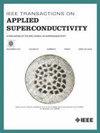Electro-Thermal and Mechanical Analysis of the HTS Split Coil Test Facility for the Muon Collider Cooling Section
IF 1.7
3区 物理与天体物理
Q3 ENGINEERING, ELECTRICAL & ELECTRONIC
引用次数: 0
Abstract
Within the International Muon Collider Collaboration (IMCC) and the EU funded MuCol programme, a facility was recently proposed to test the breakdown limit of the RF cavities under high magnetic fields (7 T). The magnetic configuration is similar to the one of the muon cooling sections. The LASA laboratory (jointly managed by INFN and University of Milan) in Milan, Italy, is currently working on the magnet design, consisting of a split coil made by high temperature superconductors (HTS) operated at 20 K for energy saving. The coils are of non-insulated type, with a relatively high interturn resistance to limit heating during current ramp up. In the present work, the results of a detailed study on the mechanical design of the HTS split coil support structure are presented together with the coupled electro-thermal analysis of the magnet during the ramp-up transient, optimizing for the coil temperature margins and cryocooler performances. These results will be integrated into a more detailed engineering design which is currently under way, serving as baseline for the construction of the test facility. In case of successful funding round by 2025, the facility could be commissioned by 2027.介子对撞机冷却段高温超导分裂线圈试验装置的电热和力学分析
在国际μ子对撞机合作项目(IMCC)和欧盟资助的MuCol项目中,最近提出了一种设备,用于测试高磁场(7 T)下射频腔的击穿极限。其磁结构与μ子冷却部分相似。位于意大利米兰的LASA实验室(由INFN和米兰大学联合管理)目前正在进行磁体设计,该磁体由高温超导体(HTS)制成的分裂线圈组成,在20 K下工作以节省能源。该线圈为非绝缘型,匝间电阻相对较高,以限制电流上升时的加热。在本工作中,详细研究了高温超导分裂线圈支撑结构的机械设计结果,并对磁体在爬坡瞬态过程中的耦合电热分析进行了分析,优化了线圈的温度裕度和制冷机的性能。这些结果将集成到目前正在进行的更详细的工程设计中,作为测试设施建设的基线。如果在2025年之前成功融资,该设施将在2027年投入使用。
本文章由计算机程序翻译,如有差异,请以英文原文为准。
求助全文
约1分钟内获得全文
求助全文
来源期刊

IEEE Transactions on Applied Superconductivity
工程技术-工程:电子与电气
CiteScore
3.50
自引率
33.30%
发文量
650
审稿时长
2.3 months
期刊介绍:
IEEE Transactions on Applied Superconductivity (TAS) contains articles on the applications of superconductivity and other relevant technology. Electronic applications include analog and digital circuits employing thin films and active devices such as Josephson junctions. Large scale applications include magnets for power applications such as motors and generators, for magnetic resonance, for accelerators, and cable applications such as power transmission.
 求助内容:
求助内容: 应助结果提醒方式:
应助结果提醒方式:


